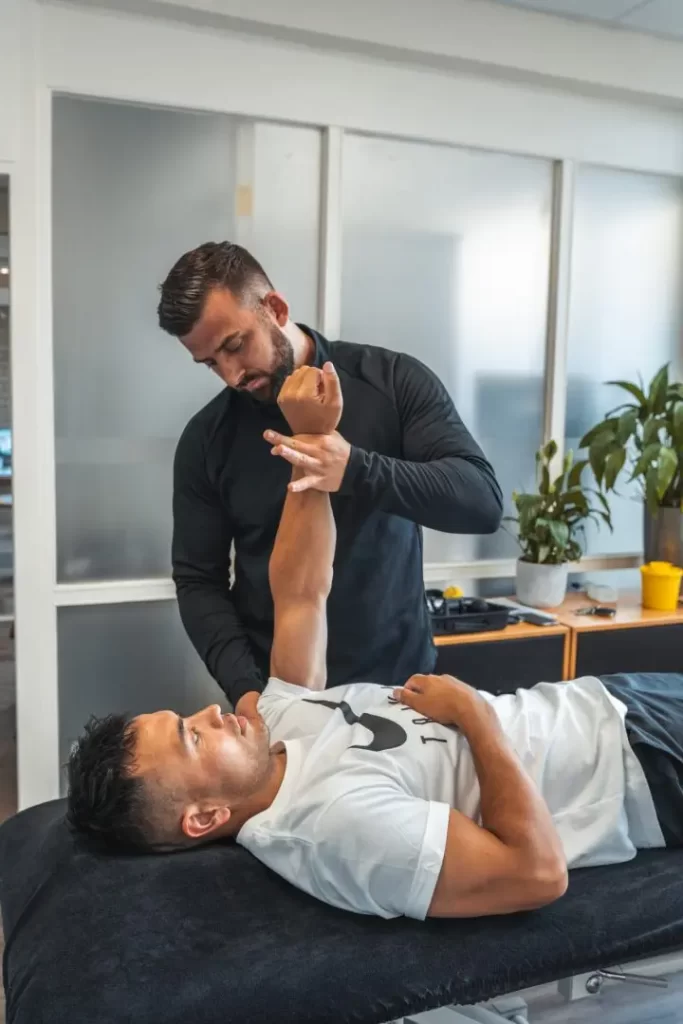Runners Knee
In runners' knee, symptoms are experienced on the outside of the knee due to irritation of a tendon, namely the tractus iliotibialis. Besides pain, there may also be stiffness. We thus speak of a tendon injury. It is often the result of increased daily or weekly strain on the body. From the pelvis (spina iliaca anterior superior) springs the musculus tensor fascia latae, which turns into the tractus iliotibialis and attaches to the outside of the lower leg. The tractus iliotibialis provides stability to the outside of the knee. Sometimes complaints arise at the tendon structure at the level of the knee (often sports-related). Some studies suggest that the tendon structure cannot experience friction due to fibres that stop it (Kaplan Fibers). Other studies suggest that it can. Patients frequently refer to a 'chafing' sensation anyway in which pain is also experienced. Pain is usually experienced on the outside of the knee when bending and stretching during, for example, running. Pain in this case is an alarm bell from your body indicating that the tendon structure does not actually like the strain at that moment. You often see this when the intensity or frequency of training has been increased in a short period of time.

These factors increase the risk of developing a runners knee
- Occurs more often in women than men, presumably related to a different pelvic position and how this affects the hip and knee.
- People with O or X-legs have an increased risk because this requires the tendon to withstand greater forces.
- High-intensity, high-impact sports; running,fast walking, hiking, etc.
Complaints
When someone continues to walk with tendon problems for a long time without dealing with them adequately, the structure of the tendon can change. This is because the tendon does its best to recover after activities but does not get around to it. The moment you deal with tendon problems adequately, recovery will start to occur over time. We do know that recovery from this type of injury can take a long time. This is because tendon tissue normally requires relatively little oxygen (up to 7.5x less than a muscle). This makes recovery from this type of complaint take much longer compared to recovery from a muscle-related complaint. Characteristics for runners knee complaints are:
- Pain on outer side of knee
- Walking downhill or walking on narrow paths can trigger the symptoms.
- Stiffness when starting to move (after sitting for some time or morning stiffness).
Pain symptoms can be experienced during higher-intensity activities such as running and jumping. We can classify runners' knee complaints into different stages. This gives us an idea of the severity of the complaints.
Treatment and rehabilitation
- Balance and recovery: When a tendon is overloaded, a good balance between load and rest is important for recovery to take place. Load is ultimately necessary to get the tendon back in good shape.
- First phase of recovery: In the first phase, pain may still be present. The earlier symptoms are recognised, the less irritation will be developed in the tendon.
- Training by means of a pain score: the load stimulus can be slowly built up over time, constantly stimulating further recovery. We accept some discomfort with a pain score up to a maximum of 4 on a scale from 0 (nothing) to 10 (extreme pain).
- No complete rest. Did you know that complete rest is definitely not the way out for this type of complaint? In fact, research has shown that a tendon of people who take complete rest shows the same characteristics as the tendon of someone who keeps overloading it. Reducing the intensity is sometimes enough to continue training with a runners knee.
Stages of a runners knee
Stage 1; there is pain and/or stiffness after exercise
Stage 2; there is pain during warm-up. These disappear when you warm up properly.
Stage 3; pain symptoms are present throughout sports activity.
Stage 4; pain is present even more than 24 hours after exercise and during daily activities.
Case study example
You have recently started running with the goal of running a marathon. You have been exercising all your life, so you notice that running comes easily to you conditionally. Recently, you started feeling some pain on the outside of your knee after running. The pain quickly subsides, so you decide to continue your training and build up your training kilometres. So you suddenly run 20km a week in a very short period of time. The pain is initially only present after training, but also moves to during training and at rest. Running becomes less and less smooth and you are held back by a painful knee. Running goes less and you're balking. This 'case study', is a typical example of wanting to build up the load on your body too quickly. Often, fitness is not the problem but your tendons are not used to the load, so they protest and you start experiencing pain.
Making an appointment at FysioFitaal
We work from multiple locations in Tilburg, always close by for professional and accessible physiotherapy. Fill in the contact form and we will contact you soon. Together, we will work on your recovery!

